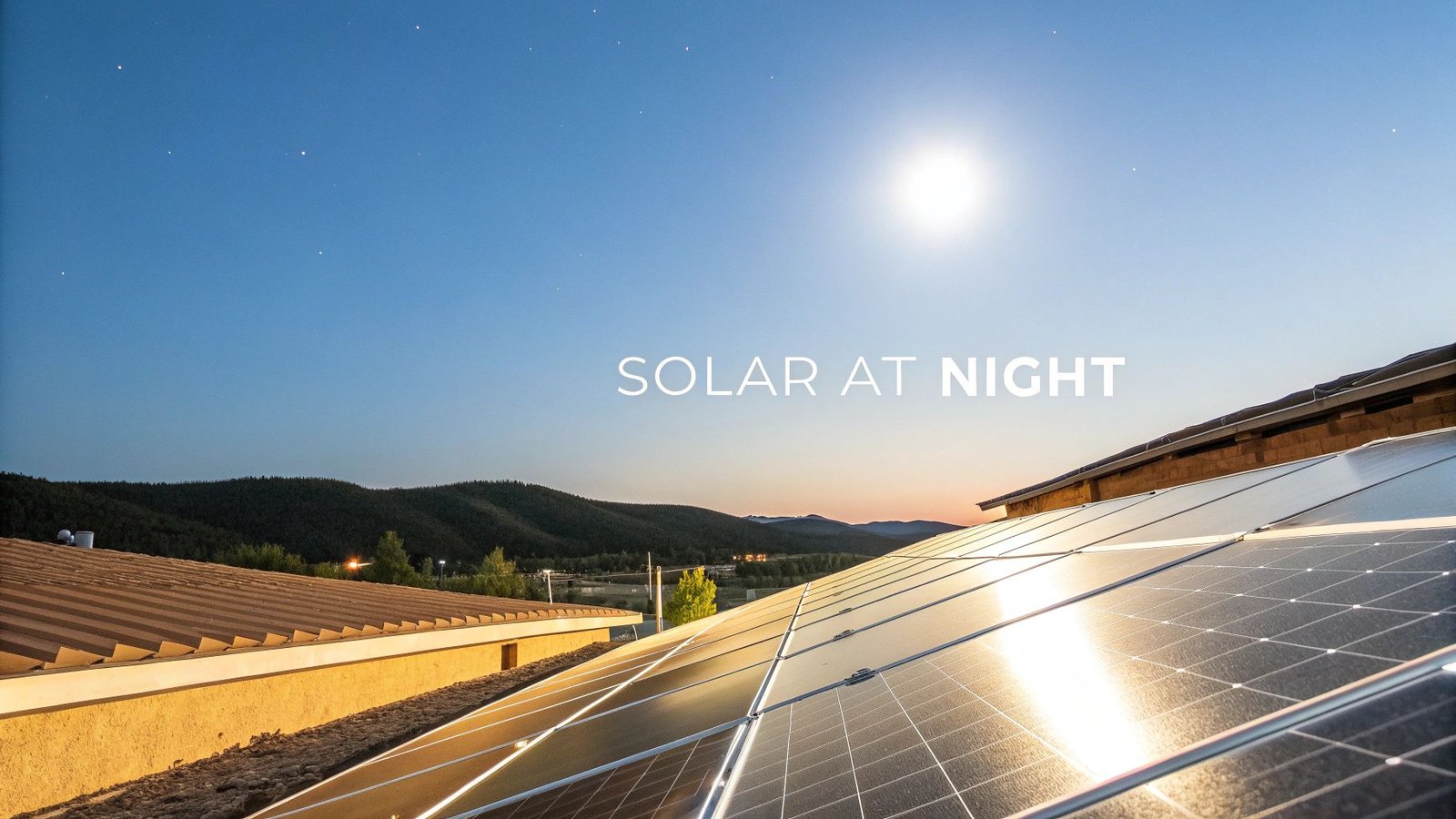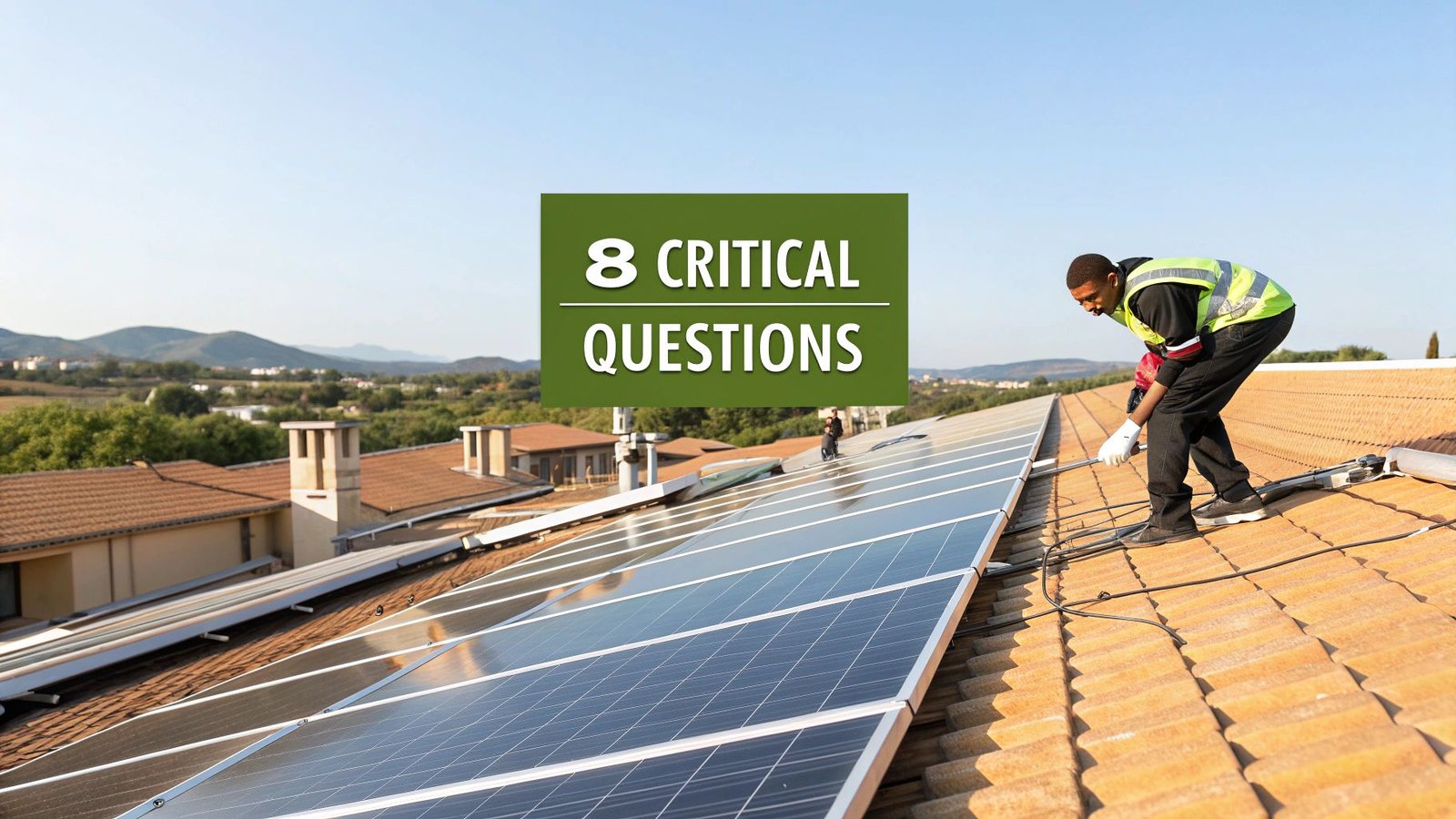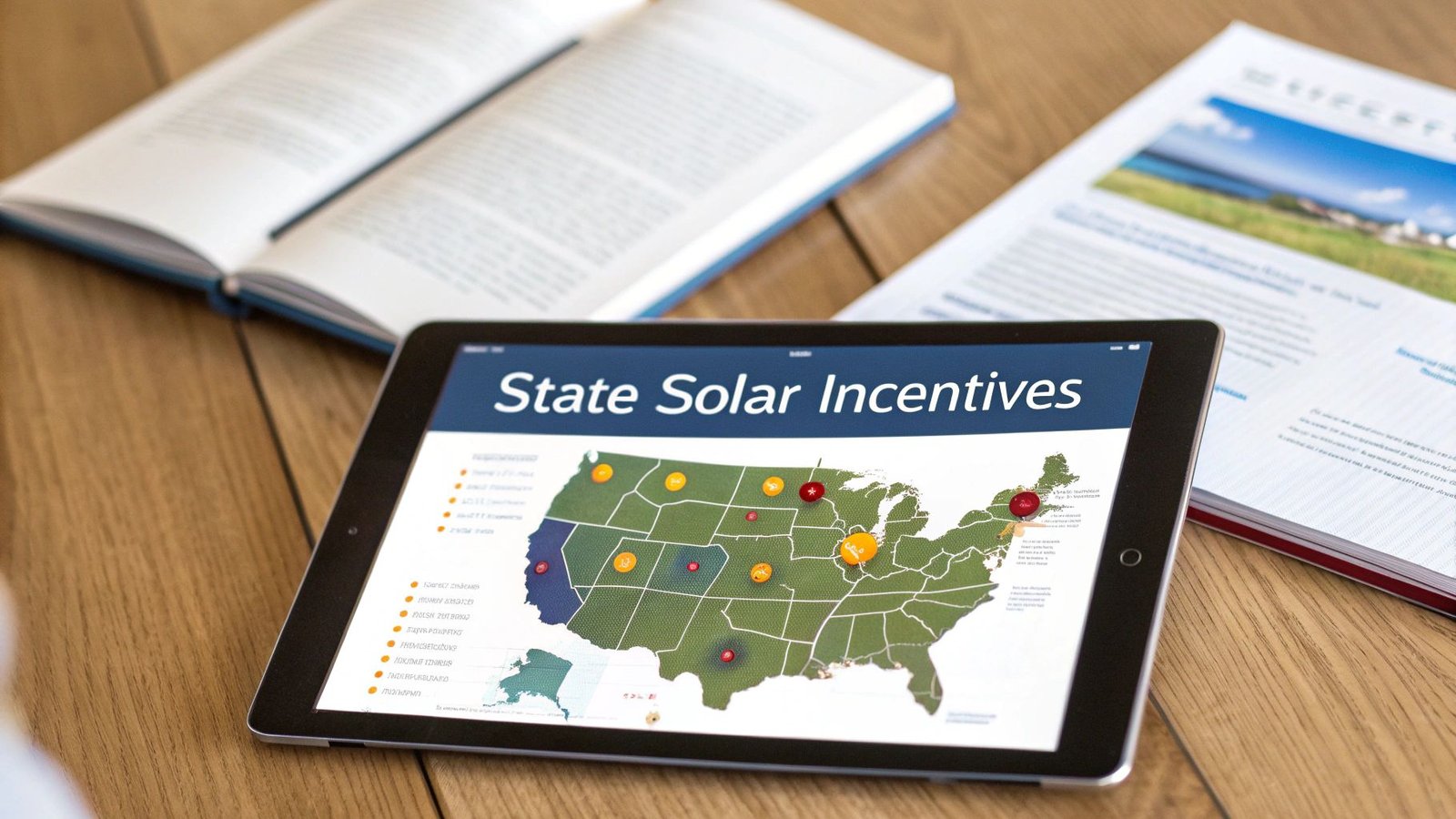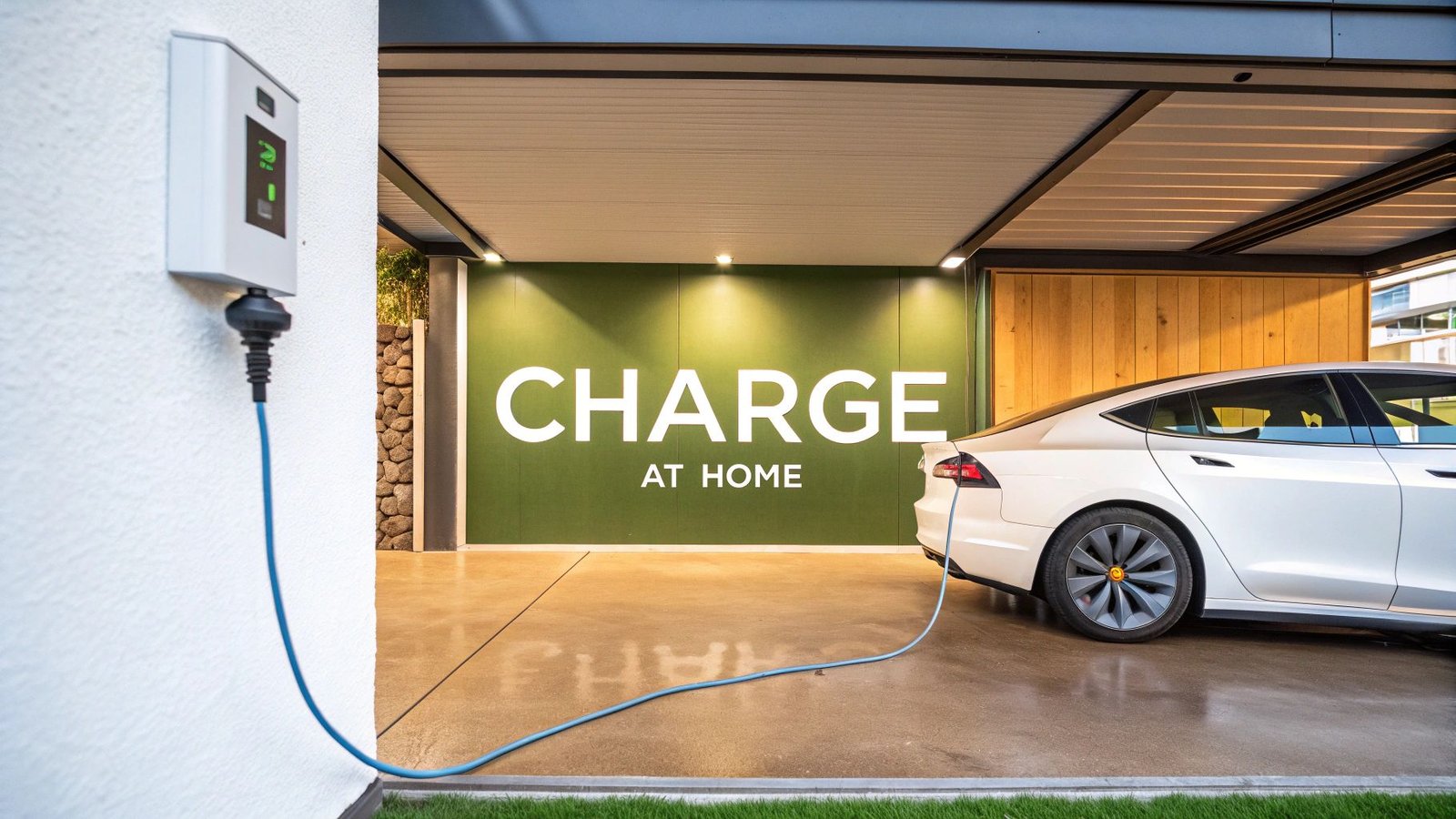Let's cut right to the chase: your solar panels themselves do not generate power in the dark. They absolutely need sunlight to kick off the photovoltaic effect that creates electricity. When the sun goes down, the power keeping your lights on comes from one of two places: a solar battery that stored extra energy during the day, or the good old utility grid.
So, What Really Happens After Sunset?
Think of a solar panel like a sun-powered engine. Just like a plant uses sunlight for photosynthesis to create its food, a panel needs sunlight to make electricity. This basic principle is the heart of what is solar energy. Without the sun's photons striking the panel, the whole system just sits there, waiting for morning.
A common question we get is, "What about moonlight?" It's a fair thought, since moonlight is just reflected sunlight. The problem is, it’s incredibly faint.
Why Moonlight Doesn't Cut It
The photovoltaic (PV) effect that powers your home depends on sunlight being strong enough to knock electrons loose inside the panel's silicon cells, creating an electrical current. Moonlight, however, is only about 0.0002% to 0.00003% as intense as direct sunlight. That's just not enough juice to get the process started in any meaningful way.
Chart: Light Source Intensity vs. Solar Panel Output
Sunlight (Direct) ☀️: ████████████████████ 100% Moonlight (Full Moon) 🌕: ▫️ <0.001% Streetlight 💡: ▫️ <0.001%This visual representation shows the vast difference in energy intensity. Moonlight and artificial lights are negligible compared to direct sunlight for power generation.
To understand how you can actually enjoy solar power long after sunset, we have to look past the panels themselves and at the entire system.
Day vs Night Solar Panel Operation
Here’s a quick breakdown of how a panel's function changes from day to night.
| Condition | Daytime Operation | Nighttime Operation |
|---|---|---|
| Energy Source | Direct & Ambient Sunlight | None |
| Panel Status | Actively Generating Power | Inactive / Dormant |
| Electricity Output | High | Virtually Zero |
This table makes it clear: the panels do the work during the day, but other components take over once it gets dark.
Powering Your Home with a Solar Battery
It's a common question: if solar panels only work when the sun is out, how do you get power at night? The answer is simple: you store the extra energy they generate during the day. The most popular way to do this is with a solar battery, which works like a personal energy reserve for your home.
Think of it this way. On a bright, sunny afternoon, your panels are often cranking out more electricity than your house needs. Instead of just letting that valuable power disappear, the surplus gets sent straight to your battery, charging it up for later. It’s a lot like topping off a power bank so you have energy on demand.
How the System Works Together
The whole process is a smooth, automated dance between your solar components. Your panels produce direct current (DC) electricity, which is then sent to a solar inverter. The inverter’s job is to convert that into alternating current (AC) electricity—the kind that runs your appliances—and from there, it powers your home. Anything left over goes right into the battery.
This infographic gives you a great visual of how the energy flow changes from day to night.

You can see the panels working hard during the day, powering the home and filling the battery. Then, as the sun sets, the battery seamlessly takes over the job of keeping the lights on.
When evening comes, your system automatically switches from pulling power from the panels to drawing from the stored energy in the battery. The transition is so fast you won't even notice it happened. You can keep watching TV, cooking dinner, and running your home just like you normally would.
The Brains Behind the Battery
Today’s solar batteries are incredibly smart. They’re equipped with advanced software that acts as an energy manager, automatically deciding whether to store power, use it in the house, or (if you're still connected) pull from the grid. This intelligent control makes sure you’re always tapping into the cheapest energy source possible.
By producing and storing your own electricity, a well-designed solar and battery system dramatically cuts down your dependence on the local utility company. You get a new level of energy independence and a solid defense against unpredictable rate hikes.
A typical 10 kWh solar battery can run the essential appliances in an average home for hours, easily covering the evening peak when energy use is highest. For many households, that’s more than enough power to last until the sun rises again.
For many homeowners, adding a battery is what truly unlocks the full value of going solar. It's the key to keeping things running smoothly after dark and during a power outage. To dig deeper, check out our guide to battery backup systems for homes. With the right setup, you can run your home on clean, solar-generated electricity 24/7.
Using the Grid as Your Energy Bank
What happens if you don't have a battery? For many homeowners, the answer is a clever arrangement called net metering. This system essentially lets you use the public utility grid as a massive, shared energy bank for your home.

On a bright, sunny afternoon, your solar panels are often working overtime, generating far more electricity than your house needs at that moment. With a grid-tied system, that extra power isn't wasted. It flows out to the grid for your neighbors to use, and your utility meter tracks every kilowatt-hour you contribute, crediting your account.
How You "Withdraw" Your Energy After Dark
Think of it like keeping a running tab with your power company. When night falls and your panels stop producing, you just pull electricity from the grid like any other home. But here's the magic: instead of getting a bill for that power, your utility company first draws from the bank of credits you built up during the day.
This two-way street is what makes solar so practical for homes without batteries. You're effectively banking your sunny-day surplus to cover your nighttime needs. This whole process is the core of Net Energy Metering (NEM), and it’s what makes grid-tied solar financially viable for millions of people.
Chart: Typical Home Energy Flow with Net Metering
Midday (High Sun)
- Solar Production: ██████████ (High)
- Home Consumption: ████ (Low)
- Result: Excess energy ██████ sent to grid (credits earned)
Evening (No Sun)
- Solar Production: (None)
- Home Consumption: ████████ (High)
- Result: Energy ████████ drawn from grid (uses credits)
Weighing the Pros and Cons
The most obvious benefit here is cost. You get the advantages of solar without the hefty price tag of a home battery system, which can make the initial investment much more manageable.
But it's not without its trade-offs.
The biggest drawback of relying on the grid is that you’re still tied to utility company rules. Policies on net metering can and do change, which could impact the value of your credits and your overall savings down the road.
Another thing to watch for is how your utility charges for power. Many are moving to time-of-use electricity rates, where electricity costs more during peak evening hours. This can complicate the simple math of net metering.
Finally, a standard grid-tied system won't keep your lights on during a blackout. For safety, your solar system has to shut down when the grid goes down. A battery, on the other hand, can provide that crucial backup power.
Choosing Your Nighttime Solar Strategy
When you're figuring out how to get power from your solar panels after dark, you'll eventually come to a fork in the road. Do you store your own power with a solar battery, or do you use the grid as a giant, shared battery through net metering?
There’s no single right answer here. The best choice really boils down to your budget, where you live, and what you want to get out of your solar investment.
Think of a solar battery as your personal energy savings account. All that extra power your panels produce during the sunny afternoon gets deposited into the battery. At night, or even when a storm knocks out the power grid, you can withdraw that energy to keep your home running. This is the path to true energy independence.
Net metering, on the other hand, is more like using a bank. You "deposit" your excess solar energy into the utility grid, and in return, you get credits on your bill. When you need power at night, you "withdraw" it from the grid, and your credits cover the cost. It’s a simpler, more affordable way to start, but you’re still connected to—and dependent on—the utility.
Deciding Between a Battery and the Grid
So, how do you choose? It helps to put the two options side-by-side to see how they stack up based on what matters most to you.
Solar Battery Storage vs Net Metering
This table breaks down the key differences to help you think through which system makes sense for your home and lifestyle.
| Feature | Solar Battery Storage | Net Metering |
|---|---|---|
| Upfront Cost | High initial investment | Low to no extra cost |
| Energy Independence | High (provides blackout protection) | Low (system shuts down in an outage) |
| Long-Term Savings | Predictable; avoids rate hikes | Variable; depends on utility policies |
| Maintenance | Minimal, but adds a component | None beyond the basic solar system |
Ultimately, your decision comes down to a few core questions. Are you aiming for the lowest possible upfront cost, or are you playing the long game for energy security? Are the net metering policies in your area stable and financially attractive, or are local utilities starting to scale them back?
For many homeowners, the choice really hinges on one critical factor: blackout protection. If you absolutely need to keep the lights on during a grid outage, a solar battery is the only option that delivers.
Answering these questions honestly will point you toward the right strategy, ensuring your solar panels are still working hard for you long after the sun has set.
The Future of 24/7 Solar Power
So far, we've talked about storing solar energy for later. But what if the panels themselves could actually generate power after the sun goes down? It sounds a little out there, but this is the focus of some incredible research that could completely change the game.

This isn't science fiction. The concept is built on a process that happens every single night: radiative cooling.
Ever walked barefoot on a sidewalk on a clear morning and noticed how chilly it is? That's because it spent all night radiating its heat up into the cold vacuum of space. Scientists are now designing panels that can capture that same effect.
By doing this, they create a small but measurable temperature difference between the panel's surface and the air around it. When you attach a thermoelectric generator to this setup, that temperature gap can be converted directly into a trickle of electricity.
The Dawn of Nighttime Generation
Let's be clear: this field is still very new, but the initial results are fascinating. Researchers at Stanford University, for example, have already built panels that integrate thermoelectric generators to do exactly this. They successfully captured the heat radiating off the panel's surface at night to generate power.
While the power generated is currently modest—enough to power a small device—the proof of concept is a monumental step forward. It opens the door to a future where solar infrastructure continues to produce energy around the clock.
This technology won't be powering your whole house through the night anytime soon. Still, it gives us a real glimpse into what's on the horizon for solar energy.
Turning these experiments into practical solutions will require more work and investment, which is where programs offering high-impact energy tech funding come into play. These developments could one day shift our entire approach from just storing solar power to generating it continuously, day and night.
Got Questions About Solar After Sundown?
Alright, we've covered how solar panels can keep the lights on long after the sun has set. But you probably still have a few questions rolling around. Let's tackle some of the most common ones people ask when they're figuring all this out.
What Happens if the Grid Goes Down at Night?
This is a big one. The answer is yes, you can have power, but only if you have a solar battery.
A standard grid-tied solar system, by law, has to shut itself off during a blackout. This is a safety measure to protect utility workers who are trying to fix the lines. Without it, your panels would be sending electricity back into the grid, which could be extremely dangerous for them.
But when you add a battery into the mix, everything changes. Your system can safely disconnect from the grid and use that stored energy to power your home. It essentially creates a mini-power grid just for you, keeping the essentials running and giving you real peace of mind.
Am I Paying for Electricity at Night with Solar?
It really boils down to your specific setup and how much power you're using.
- If you have a solar battery: You'll be running on the free, clean energy you stored up during the day. If your battery is the right size for your home, you won't pay a dime to your utility company at night.
- If you use net metering: You'll draw power from the grid, but you'll pay for it with the credits you earned by sending your extra solar energy to the grid earlier. You only get a bill if you use more power than you have credits to cover.
The whole point of a well-designed solar system is to dramatically cut, or even completely wipe out, your nighttime electricity costs. It's all about using either stored battery power or those grid credits to your advantage.
Is a Hybrid Solar System the Way to Go?
For a lot of homeowners, a hybrid system is the perfect fit. It gives you the best of both worlds: a connection to the grid and a battery backup.
This setup lets you play the net metering game when it makes sense, but you also have that battery ready for nighttime power and, most importantly, for when a blackout hits. It's the ultimate combination of flexibility, savings, and security.
Can My Panels Get a Little Charge from Streetlights or the Moon?
In a word, no. While it’s a creative thought, the light from a streetlamp or even a bright full moon is thousands of times too weak to get the electrons in your panels moving.
Solar panels are engineered to respond to the intense energy of sunlight. Any other light source is just too faint to produce any measurable amount of electricity. At night, without the sun, they're essentially dormant.
Ready to achieve energy independence and power your home day and night? At Radiant Energy, we design and install high-quality solar and battery storage solutions tailored to your needs.
Explore our custom solar solutions and get a free quote today!




